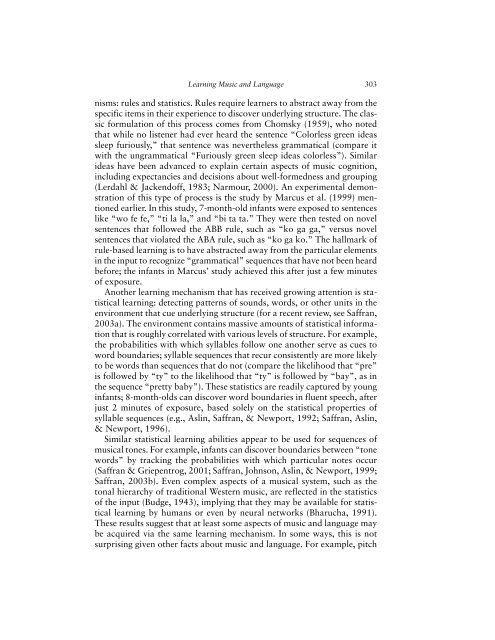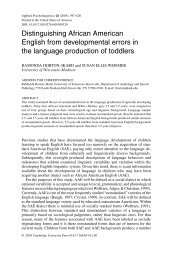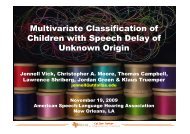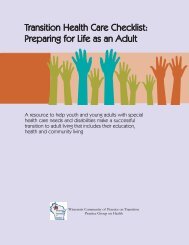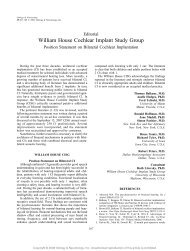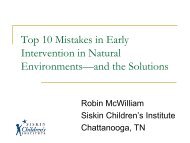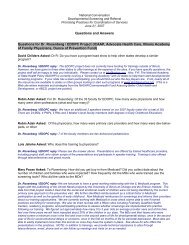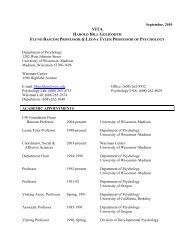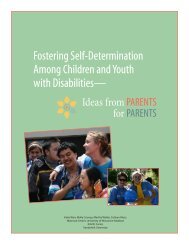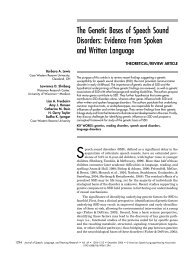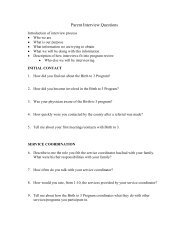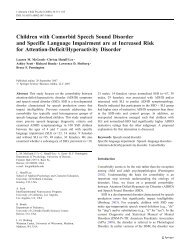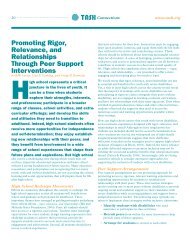Music and Language: A Developmental Comparison - Waisman ...
Music and Language: A Developmental Comparison - Waisman ...
Music and Language: A Developmental Comparison - Waisman ...
Create successful ePaper yourself
Turn your PDF publications into a flip-book with our unique Google optimized e-Paper software.
Learning <strong>Music</strong> <strong>and</strong> <strong>Language</strong>303nisms: rules <strong>and</strong> statistics. Rules require learners to abstract away from thespecific items in their experience to discover underlying structure. The classicformulation of this process comes from Chomsky (1959), who notedthat while no listener had ever heard the sentence “Colorless green ideassleep furiously,” that sentence was nevertheless grammatical (compare itwith the ungrammatical “Furiously green sleep ideas colorless”). Similarideas have been advanced to explain certain aspects of music cognition,including expectancies <strong>and</strong> decisions about well-formedness <strong>and</strong> grouping(Lerdahl & Jackendoff, 1983; Narmour, 2000). An experimental demonstrationof this type of process is the study by Marcus et al. (1999) mentionedearlier. In this study, 7-month-old infants were exposed to sentenceslike “wo fe fe,” “ti la la,” <strong>and</strong> “bi ta ta.” They were then tested on novelsentences that followed the ABB rule, such as “ko ga ga,” versus novelsentences that violated the ABA rule, such as “ko ga ko.” The hallmark ofrule-based learning is to have abstracted away from the particular elementsin the input to recognize “grammatical” sequences that have not been heardbefore; the infants in Marcus’ study achieved this after just a few minutesof exposure.Another learning mechanism that has received growing attention is statisticallearning: detecting patterns of sounds, words, or other units in theenvironment that cue underlying structure (for a recent review, see Saffran,2003a). The environment contains massive amounts of statistical informationthat is roughly correlated with various levels of structure. For example,the probabilities with which syllables follow one another serve as cues toword boundaries; syllable sequences that recur consistently are more likelyto be words than sequences that do not (compare the likelihood that “pre”is followed by “ty” to the likelihood that “ty” is followed by “bay”, as inthe sequence “pretty baby”). These statistics are readily captured by younginfants; 8-month-olds can discover word boundaries in fluent speech, afterjust 2 minutes of exposure, based solely on the statistical properties ofsyllable sequences (e.g., Aslin, Saffran, & Newport, 1992; Saffran, Aslin,& Newport, 1996).Similar statistical learning abilities appear to be used for sequences ofmusical tones. For example, infants can discover boundaries between “tonewords” by tracking the probabilities with which particular notes occur(Saffran & Griepentrog, 2001; Saffran, Johnson, Aslin, & Newport, 1999;Saffran, 2003b). Even complex aspects of a musical system, such as thetonal hierarchy of traditional Western music, are reflected in the statisticsof the input (Budge, 1943), implying that they may be available for statisticallearning by humans or even by neural networks (Bharucha, 1991).These results suggest that at least some aspects of music <strong>and</strong> language maybe acquired via the same learning mechanism. In some ways, this is notsurprising given other facts about music <strong>and</strong> language. For example, pitch


